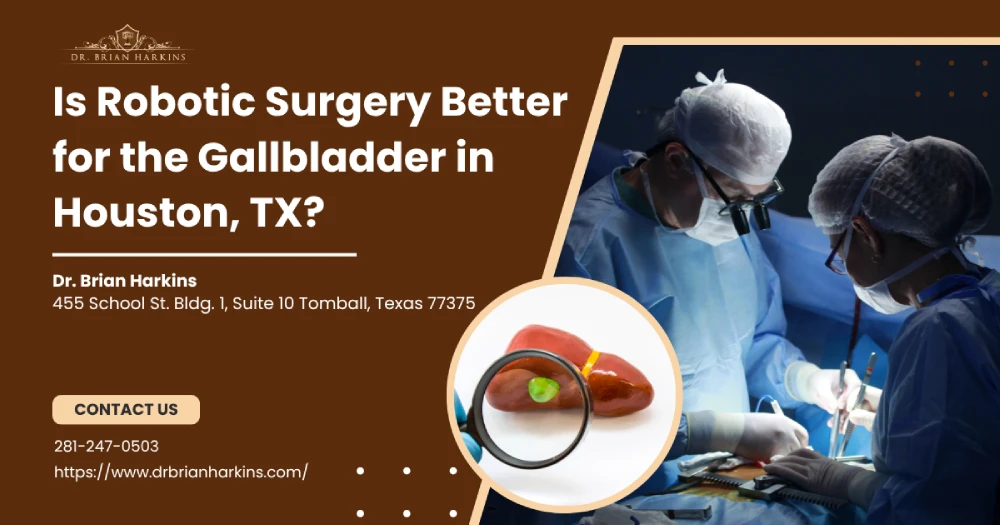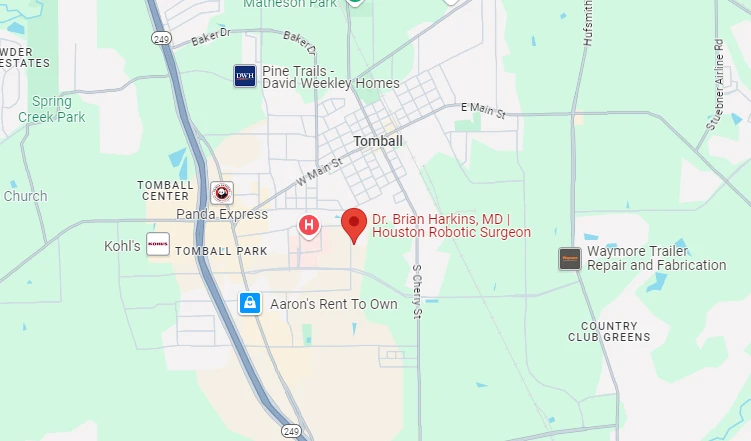
Gallbladder pain can upend your life, and modern surgical technology promises faster, gentler fixes—but is robotic surgery better for the gallbladder in Houston, TX? While robotic surgery is a viable option, it’s not always the best choice, and the surgeon should discuss the risks and benefits with the patient during consultation. Below you’ll find an honest, Houston-focused look at how robotic gallbladder surgery stacks up against other types of surgical procedures so you can walk into your consultation feeling confident.
Choosing how to remove a troublesome gallbladder isn’t a one-size-fits-all decision. Houston surgeons offer multiple surgery techniques that range from traditional open surgery to cutting-edge robotic procedures. Before you decide, it helps to understand the surgical landscape and the health issues that push doctors to recommend an operation for you.
Most gallbladder removals—known medically as cholecystectomies—are done for:
If you’re only dealing with silent stones, your general surgery specialist may suggest “watchful waiting.” Once pain or infection flares, surgery becomes the definitive cure and often leads to quicker recovery than repeated ER visits.
The Greater Houston medical community offers three main approaches, each a distinct type of surgery with its own recovery period and cost profile:
Each option involves the removal of the gallbladder; the difference lies in visualization, dexterity, incision length, and overall cost.
Imagining a robot at your bedside can feel futuristic. In practice, robotic-assisted surgery provides your surgeon with ergonomic controls, tremor filtration, and a magnified, high-definition view of the surgical site. The human expert remains in charge; the robot merely extends the surgeon’s hands.
Total operating-room time depends heavily on staff experience with robotic techniques. Seasoned teams can match or even beat laparoscopic times, while low-volume centers may take longer.
Patients often want a side-by-side snapshot rather than scattered anecdotes. The table below condenses peer-reviewed data and regional cost estimates so you can compare minimally invasive and traditional surgery on equal footing:
| Factor | Robotic | Laparoscopic | Open |
|---|---|---|---|
| Average Incision Length | 8 mm ports (3–4) | 10 mm + 5 mm ports | 10–15 cm right-subcostal |
| Typical OR Time (Houston Averages) | 75–105 min | 60–90 min | 90–120 min |
| Estimated Hospital Charge | $20k–$26k | $14k–$18k | $25k–$30k |
| Post-Op Stay | Same-day or 23-hour | Same-day or 23-hour | 2–4 days |
| Return to Desk Job | 5–7 days | 5–7 days | 14–21 days |
| Scar Visibility | ~1 in blended in folds | ~1 in blended in folds | 4–6 in obvious scar |
| Ideal For | Obesity, prior surgery, cosmetic focus | Routine stones/infection | Severe inflammation, cancer |
Randomized trials show no significant difference in bile-duct injury, bleeding, or infection rates between robotic and laparoscopic cholecystectomy when performed by skilled surgeons. Pain scores and narcotic use trend slightly lower with robots, but the margin is small, and both minimally invasive techniques offer a noticeably quicker recovery than traditional open surgery.
Houston’s major carriers—Blue Cross, United, Aetna, and Cigna—cover robotic surgery if medically justified, yet the facility fee is higher because of the robotic equipment. Confirm in-network status, surgeon billing codes, deductible, and coinsurance amounts before the procedure.
Deciding on robotic assistance means balancing tangible perks against very real downsides. Here’s the nuanced picture beyond marketing brochures:
State-of-the-art hardware is useless if patient or surgeon factors don’t align. Recognize the traits that nudge someone toward—or away from—the robot.
A candid conversation is the linchpin of an informed decision. Arm yourself with specific, practical questions rather than broad “Is it safe?” inquiries.
Look for board-certified general or colorectal surgery specialists who:
Even the slickest technology can’t replace diligent post-op care. Smart habits accelerate healing and keep complications at bay.
Modern medicine offers dazzling options, yet the oldest rule—“the right tool in the right hands”—still applies. Evaluating surgeon expertise, hospital support, cost transparency, and your personal health profile leads to the safest outcome, whether metal wrists or human hands hold the instruments.
Robots deliver precision, but they’re not magic. Clinical outcomes for robotic and laparoscopic gallbladder surgery are largely equivalent in healthy adults. You’ll likely bounce back within a week either way. Higher fees and longer set-up times temper the high-tech allure, making surgeon skill, case complexity, and your insurance coverage the real deciding factors. When you meet with your Houston surgeon, bring pointed questions about experience, complication rates, and costs. That open dialogue ensures you choose the technique—robotic, laparoscopic, or open—that best fits your unique needs and goals. Ready to schedule that conversation? Make a list, pick up the phone, and take charge of your gallbladder game plan.
Not significantly. Most patients return to normal activity within 5–7 days with either technique. Robotic may reduce shoulder-tip pain slightly, but the total recovery timeline is nearly identical.
Yes, age alone isn’t a contraindication. Because the system is minimally invasive, seniors often appreciate the smaller incisions and lower blood-loss profile. The key is cardiac and pulmonary clearance for general anesthesia. Discuss underlying conditions with your anesthesiologist and surgeon before committing to any surgical procedure.
Sometimes. The hospital must have the robot available, a trained team on duty, and your insurance pre-authorization in place. Surgeons with dual privileges can pivot if scheduling and coverage allow. However, sudden changes can raise facility fees, so ask about cost implications before making a same-day decision.
Robotic platforms have stringent safety protocols. If a malfunction occurs, your surgeon undocks the robot and continues laparoscopically or converts to open surgery if necessary. Backup instruments are always in the room, and conversion doesn’t typically affect outcome as long as the surgical team acts promptly.
Robotic ports are usually 8 mm, resulting in incisions about one-third of an inch. Most surgeons hide them in the navel or along natural skin creases. Over six months, scars fade to hairline-thin marks that are hard to spot unless you’re specifically looking.
Follow-up is similar to laparoscopic cases: one office visit 7–14 days post-op for wound check, with additional visits only if problems arise. Because incisions are tiny, suture removal is rarely needed; surgeons typically use dissolvable stitches or surgical glue.
No. Studies show comparable or even slightly lower bile-duct injury rates with robotic techniques, largely due to the magnified, 3-D view of the surgical field. Nonetheless, surgeon experience remains the dominant factor in preventing this serious complication.
Robotic arms can accommodate high-BMI patients better than standard laparoscopic tools, so obesity isn’t generally a barrier. Table weight limits—usually 500–550 lbs—are the main constraint. Pre-operative imaging helps confirm port placement and docking feasibility.
Light walking is encouraged within 24 hours. Most patients resume low-impact cardio by week two and strength training by week four, provided they avoid heavy abdominal strain. Always follow your surgeon’s customized timeline based on your healing progress and overall fitness level.
The da Vinci platform is increasingly common in community settings across the Houston area. Still, academic centers may offer dual consoles for teaching, advanced imaging modules, and 24-hour robotics teams. Ask each facility about case volume, team training, and available technology before making a choice.


Dr. Brian Harkins is a renowned surgeon specializing in advanced, minimally invasive, and robotic surgical techniques. With a dedication to innovation and personalized patient care, he has transformed countless lives by delivering exceptional outcomes.

I want a website like this, where do i start?